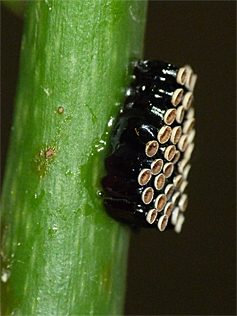
It was a little over a week ago that Lew (Horticulture Specialist) brought a small potted plant into my office. It was a nice enough plant, but in the back of my mind I wondered why he would bring it to me, what was special about this plant. Then he pointed to the main stalk of the plant. There were Wheel Bug eggs on the stalk.
A week or so before, someone had spotted a mating pair of Wheel Bugs outside of the Butterfly House. Always on the lookout for insects to put on display during the winter months, the Wheel Bugs became residents of the “holding room.” If the female wheel bug laid eggs, and they hatched, perhaps the resulting wheel bugs would make a nice display. She did lays eggs. This particular cluster contained over fifty eggs, a healthy number to have on display.
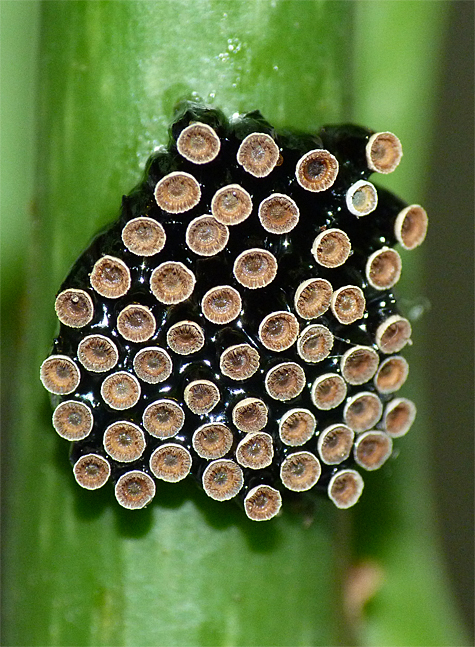
Typically, wheel bug eggs overwinter, hatching out (in our area) in April. The eggs hatch out all at once, or nearly so. If you happen on one of these hatchings you may see anywhere from perhaps forty to two hundred red-abdomened nymphs standing around waiting for something to eat to come walking by. Wheel Bugs are predators. They eat other insects.
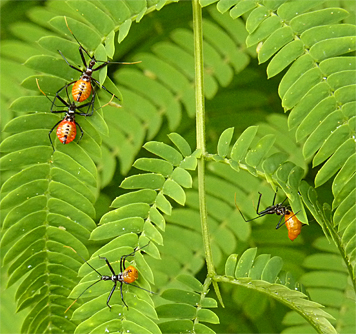
The nymphs soon begin to disperse and head out for new areas to wait in ambush for unsuspecting insects to pierce with their long and deadly proboscis. The wheel bug pounces on careless insects, jabing them with the proboscis which is otherwise folded and stored beneath the insect’s head. Enzymes injected into the prey immobilize it, turning the internal organs into a liquid which the wheel bug can then suck up through the dual purpose proboscis.
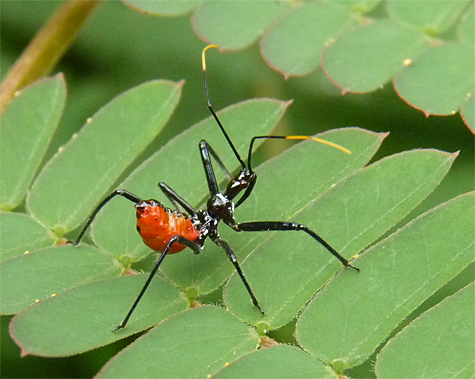
Most of us don’t really notice the wheel bugs throughout the rest of spring and summer. With each successive molt their red “warning” coloration is slowly replaced by more subtle tones of gray and brown. They don’t move fast, whether in the air or on foot, so they can be easily overlooked.
It’s not until September or October that they seem to reappear, in much different attire. They are now almost entirely gray with browns highlighting their legs, antennae, and deadly proboscis. Their most obvious feature in the adult stage is the cog-like “wheel” on their back. If you see one of these insects you should know right away what it is, a wheel bug.
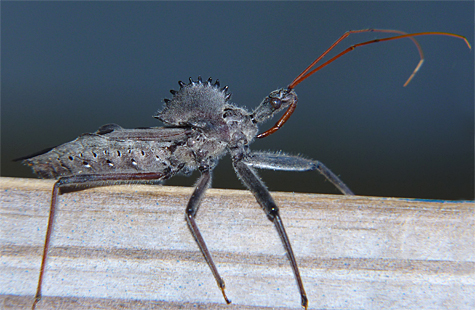
Oh, by the way, if you feel that you must pick one up to examine it closer, use tweezers. I don’t know from personal experience but I’ve read that they can give a painful bite, or jab, with that proboscis of theirs. They don’t move very fast, they’re in fact slow, so don’t worry about them jumping on you and attacking. If you get to experience the pain of a wheel bug, it’ll be your own carelessness that takes you there.
We don’t know if the wheel bug eggs in the Insectarium “holding room” will hatch or not. They’re being kept inside in the hopes that the warmer temperatures will force them to do so sooner rather than later next spring. It’s an experiment, and we’ll just have to wait and see what happens.
If they do hatch we may get to experience these fascinating predators close-up and witness the entire process of growth from egg to adult wheel bug.
I’ll keep in touch with any news.
My 5 year old spotted Wheel bugs [eggs] that were laid on the inside of our back door. She then noticed the eggs began to hatch out but not all at one time. I collected then very carefully by Q-tips and placed them in a plastic container. Today, I decided to release them all outside on my deck rails. I live in Nc and it is windter time here. Will they be o.k
The eggs can and do survive the winter but the nymphs probably won’t survive if hatched and released outside now. They typically hatch in April here in NC and by September we start seeing the fully grown adults. They may have hatched early, since as you say, the eggs were on the inside of your back door.
So, next year if and when you find eggs on your house, fence railing, or even on a twig outside of your house, make note of the location. When April rolls around keep a sharp eye out for the nymphs as they hatch out. Watch them slowly disperse, maybe catch a few, feed them small insects and watch them grow into adults. Careful though, they can give a nasty poke with that long proboscis that they use to eat their prey.
Enjoy.
I saw a brown wheel bug on my house last week. It was near some shrubbery; might there be eggs nearby? That was the first wheel bug I’ve seen in 3 or so years. The nymphs look very similar to the leaf-footed bug nymphs I’ve seen in my garden in the summer.
Yes, I would check around the shrub’s main stem or trunk, you might find a cluster of eggs.
And yes, the wheel bug nymphs do resemble leaf-footed bug nymphs. In fact they even have a similar proboscis. Some leaf-footed bugs are plant bugs sucking juices from fruits and plant stems and some are predatory like the assassin bugs, a group of insects which includes the wheel bug.
Thanks,